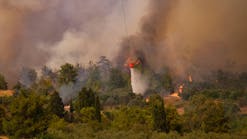Sep. 12—A fire suppression system at Brunswick Executive Airport was flagged as "deficient" 14 months before it malfunctioned and discharged more than 51,000 gallons of toxic chemical foam that state-funded clean-up crews have yet to fully contain.
The last test of the system intended to douse aviation fires revealed deficiencies in June 2023, but the airport owner, Midcoast Regional Redevelopment Authority, couldn't find a fire sprinkler company willing to fix them, Executive Director Kristine Logan said.
Logan couldn't identify the exact deficiencies, saying she isn't a "technical person," but said she knew the inspection showed that some of the system's mechanical parts, including some in a control panel, had reached the end of their service life and needed to be replaced.
She said she did not know if the deficiencies were to blame for the Aug. 19 malfunction.
The airport has two other hangars that use the same systems and hazardous chemical mixtures to douse high-intensity aviation fires. Logan said she does not know the result of their last tests, or when they were conducted, but she noted that many of their parts are probably at the end of their service life, too.
Logan said the testing company, Eastern Fire of Auburn, rebuffed her repair requests, told her it might stop servicing systems that rely on toxic foam altogether, and then told her it was increasing its annual inspection fee fourfold to $100,000.
"We went back and forth with them until September," Logan said. "So then, when we couldn't get them back in, we started calling around to other places to say 'Hey, would you guys come out and do that?' But nobody wants to do anything with PFAS anymore."
Eastern Fire did not return a call Wednesday to discuss the Brunswick Executive Airport inspection or contract terms.
The revelation about the deficient system comes three weeks after Logan discussed the Aug. 19 spill with reporters at a news conference outside her airport office. At that time, and during subsequent reports to the City Council, she said the Hangar 4 suppression system had passed its last inspection report.
Logan revealed the deficiencies only after the Portland Press Herald requested the inspection report. The paper first requested the report on Aug. 22, three days after the spill and a day after Logan told reporters that the malfunctioning system had passed its last inspection, or "come back clean."
When asked to explain the discrepancy, Logan said Wednesday that she had relied on spur-of-the-moment information supplied by her staff to answer the Press Herald's inspection history question during the Aug. 21 news conference. The conference is archived on the Brunswick town website.
Logan said "because we like to be open about everything" she was coming forward now to correct the mistake, which she only realized later after reading the inspection report herself. She agreed to make the report available Wednesday but had yet to do so at press time.
Logan could not explain how she could have repeatedly asked Eastern Fire to repair the deficiencies, tried to solicit other companies to correct them or begun working with lawyers to use Eastern Fire's refusal to deflect potential legal liability if she had only just learned of the deficiencies.
MRRA is preparing for legal action because people always look for a scapegoat, Logan said.
"If somebody points to us, and says you're liable, we are going to point, I hate to say it, but we're going to point to Eastern Fire to say there's some liability there because they're the ones who are supposed to be maintaining the system," Logan said Wednesday.
According to the U.S. Environmental Protection Agency, the Brunswick spill — 1,450 gallons of aqueous film-forming foam concentrate mixed with 50,000 gallons of water — is the sixth-largest U.S. AFFF foam spill in 30 years, behind others in Florida, Alabama, Arizona (which had two larger spills) and Ohio.
According to the EPA data, which is based on information collected by the U.S. Coast Guard's National Response Center, 1,200 spills of firefighting foam containing toxic per- and polyfluoroalkyl substances, also known as PFAS or forever chemicals, have occurred across the country since 1990.
Even trace amounts of some PFAS are considered a public health risk, according to federal regulators. High exposure over a long time can cause cancer. Exposure to small amounts during critical life stages, such as in early childhood, can also cause life-changing harm.
The toxic foam is used by firefighters to fight high-intensity fuel fires at military bases, civilian airports, fuel terminals and industrial plants that use a lot of chemicals, such as paper mills. The foam forms a film or blanket over the fire, depriving it of the oxygen it needs to burn.
Firefighting foam is the most common source of forever chemical contamination in the U.S., according to the EPA, but PFAS has shown up in trace amounts almost everywhere, from Arctic polar bears to Maine dairy farmers.
But not all foam used in all airport fire suppression systems contains forever chemicals. Airports across the country are beginning to switch over to PFAS-free foams, but they are more expensive than AFFF in part because a lot more of the newly developed safe foam is needed to put out a fuel fire.
Copy the Story Link
___
(c)2024 the Portland Press Herald (Portland, Maine)
Visit the Portland Press Herald (Portland, Maine) at www.pressherald.com
Distributed by Tribune Content Agency, LLC.
